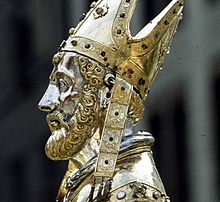Servatius of Tongeren
Servatius von Tongern (* presumably in Armenia ; † May 13, 384 in Maastricht ), Servatius for short , is one of the ice saints who is especially venerated on May 13. Until well into the 19th century, it was also known as Servaz in German .
In popular belief , Servatius is invoked with foot problems, frost damage, rheumatism and rat plagues.
According to the current state of research, two historical personalities are mixed in its shape:
On the one hand, Gregory of Tours mentions in his Historia francorum (written at the end of the 6th century) a Servatius episcopus tungrorum ( i.e. Bishop of Tongeren ) who died around 450, shortly before the invasion of Europe by the Huns . This Servatius was in fact the first bishop in today's Belgian Tongeren . In Gregory's legend of saints , this Servatius traveled to Rome , where the invasion of the Huns was foretold in an apparition by Peter . Servatius traveled back, warned the citizens of Tongeren and moved the bishopric to Maastricht , where he died shortly afterwards.
Until recently, another bearer of the same or similar name was mixed up with this Servatius: the historian Sulpicius Severus mentions a Servatius or Sarbatios from Gaul , who served in 343 at the Synod of Sardica , now Sofia in Bulgaria , and in 359 at another in Rimini participated. So he lived a hundred years before the Servatius mentioned by Gregor, at a time when there was still no talk of Christianity in the region around Tongeren. This Servatius stood out at the synods as a resolute opponent of Arianism .
Lore
In the Middle Ages , these two figures then merged into a single saint figure. This (constructed) Saint Servatius was already 340 bishop of Tongeren, now Belgium, and later moved the bishopric to Maastricht , where he died on May 13, 384 ; some claim that he was killed with a wooden shoe, others that he died peacefully in Maastricht, where he went for this very purpose.
In any case, he owes his admiration to the invasion of the Huns in 450, which he is said to have predicted.
The gap between the years 384 (the year he supposedly died) and 450 (the invasion of the Huns) has long been explained to mean that it was probably not the Huns under Attila of 450, but other wandering groups. The riddle can be solved better if, as is common today, two historical Servatius figures are assumed.
Servatius - most likely the later one - is buried in Maastricht Cathedral ( Sint-Servaaskerk ). Maastricht was therefore one of the most important pilgrimage sites of the Middle Ages. The veneration of Saint Servatius reached its peak in the middle of the 12th century. Several texts are of importance here: The Vita sancti Sarvatii , which goes back to earlier Latin versions, has come down to us in several manuscripts from the 12th and 13th centuries. They, together with the traditional in the 12th century Gesta sancti Servatii as a template for those of Heinrich von Veldeke written Middle Dutch Verslegende Sente Servas . The Upper German verse, Servatius an anonymus, written in Bavarian dialect , who also used the gesture , goes back to the latter . It is considered the first example of Dutch literary influence in Upper Germany. The author pursued a “propagandistic” intention ( de Boor ): He tried to introduce a saint there who had been unknown in Bavaria to date. He placed a focus on the invasion of the Huns and the conversion of Attila.
presentation
St. Servatius is usually depicted in the bishop's robe with a shepherd's staff. A key, wooden shoes or a dragon at his feet are given as attributes.
literature
- Karl Mühlek : Servatius. In: Biographisch-Bibliographisches Kirchenlexikon (BBKL). Volume 17, Bautz, Herzberg 2000, ISBN 3-88309-080-8 , Sp. 1290.
See also
Web links
- E-text of the Servatius legend by Heinrich von Veldeke (TITUS)
| predecessor | Office | successor |
|---|---|---|
| Maternus |
Bishop of Tongeren 342–384 |
Aravatius |
| personal data | |
|---|---|
| SURNAME | Servatius of Tongeren |
| ALTERNATIVE NAMES | Servatius; Sarbatios; Servatius episcopus tungrorum |
| BRIEF DESCRIPTION | Ice Saint, Bishop of Tongeren (342–384) |
| DATE OF BIRTH | 4th century |
| PLACE OF BIRTH | unsure: Armenia |
| DATE OF DEATH | May 13, 384 |
| Place of death | Maastricht |
